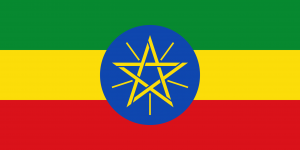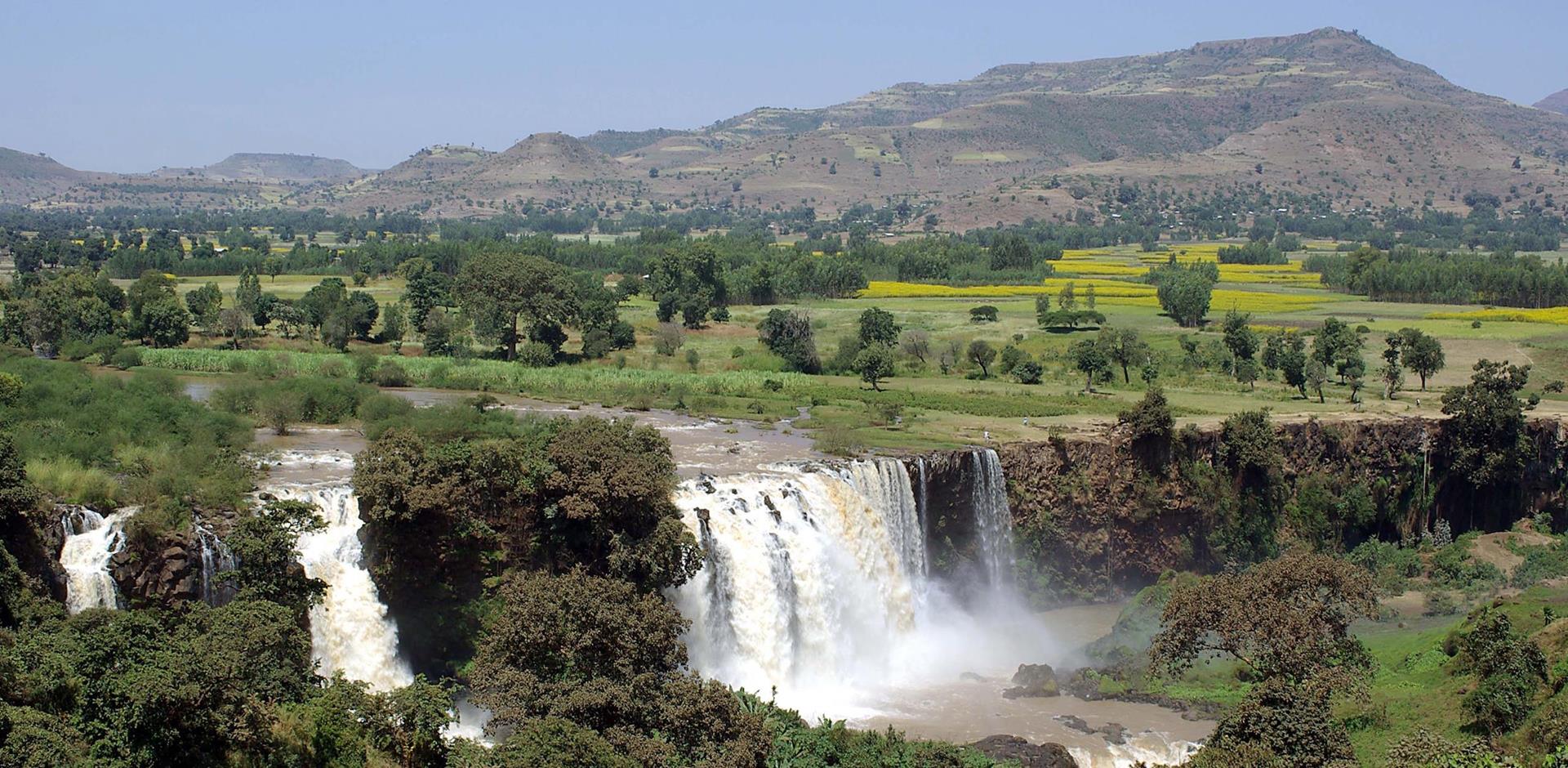Language/Amharic/Culture/Ethiopia-Timeline
Interesting Facts about Ethiopia[edit | edit source]
- Country : ETHIOPIA🇪🇹
- Capital: Addis Ababa
- Continent: Africa
- Currency: Birr
- Official Language: Amharic
1. Ethiopia is the only country in the world to have 13 months in a year. It is 7 years & 3 months behind the Western calendar.
2. They celebrate their new year on September 11.
3. Ethiopia checks its time on the inverse rotation of its clock.
4. The largest lake in Ethiopia–Lake Tana–is also the source of the Blue Nile River.
5. The oldest fossil skeleton of a human was found in Ethiopia. It is over 3 million years old.
6. The Erta Ale Volcano in Ethiopia holds the longest existing lava lake, since 1906.
7. Ethiopia is famous for the high-quality coffee it produces.
8. In Ethiopia more than 80 different languages are spoken.
9. Ethiopian Airlines is the globe’s fourth-largest airline.
10. In the Omo Valley of Ethiopia, wearing a large disc on the lower lip is considered beautiful.
11. It is said that a woman who wears a larger disc father gets more cows in dowry than a woman who wears a smaller disc.
12. Around 70% of Africa’s mountains are in Ethiopia. It is also known as " The Roof of Africa".
13. Vegetarian Cuisine Is The Pride Of Ethiopian Food.
14. Danakil Depression is the lowest and hottest place on Earth.
15. The rock-hewn churches, Omo Valley, Gondar Castle and Simien Mountain National Park are the best-known attraction of Ethiopia.
Source[edit source]
- Content Research - Ms Harshali Dhatavkar
➡ To LEARN & SHARE interesting experiences: Join the WhatsApp group
Travel Guide[edit | edit source]
Ethiopia Timeline[edit | edit source]
| Date | Event |
|---|---|
| 2000 BC AD | First mention of the land of Punt in Egyptian texts. |
| 1000-500 BC AD | Settlement of immigrants from the Arabian Peninsula on the Eritrean coast. Development of a Sabean-influenced civilization in Yéha. |
| 100-300 | Foundation of the Axumite Empire. |
| 330 | Conversion to Christianity of King Ezana. |
| 451 | Condemnation of monophysitism at the Council of Chalcedon. Secession of the Church of Alexandria. |
| 517 | Abyssinian invasion and occupation of southern Arabia (Yemen). |
| 6th century | Apogee of the kingdom of Axum. |
| 570 | The Persians invade Arabia. End of Aksumite domination on the peninsula. |
| 7th century | Persecuted Mohammedans take refuge in Aksum and enter the Horn of Africa. |
| 8th-9th centuries | Islamization of the Red Sea coasts. Aksum's economic and political decline. |
| 1137 | Establishment of the Zagoué dynasty. |
| 1185-1225 | Reign of King Lalibela. |
| 1270 | "Restoration" of the Solomon Islands dynasty by Yekouno Amlak. |
| 14th-15th centuries | Period of prosperity and relative stability under the reigns of Amda Syon (1314-1344) and Zara Yakob (1434-1468). Centralization of power, extension of Christianity, first struggles against Muslim emirs. |
| 1527-1543 | The armies of Ahmed ibn Ibrahim, known as the Gaucher (Gragn), ravage the country. King Lebna Dengel (1508-1540) appealed to the Portuguese. |
| 1543 | Death of Gragn. Muslim troops retreat to Harar. |
| 1563-1597 | Sarsa Dengel fights against the Turks and the Oromo invasions. |
| 1621 | The conversion to Catholicism, under the influence of the Jesuits, of King Sousenyos (1607-1632) causes serious unrest in the country. |
| 1635 | King Fasilidas (1632-1667) establishes his capital in Gondar and restores the authority of the Orthodox Church |
| 1706 | Assassination of King Iyassou. Gondar sinks into fratricidal struggles and the central power is declining. |
| 1769 | "Period of the princes" or "era of the judges", during which the authority of the kings of Gondar disappears in favor of that of the governors of provinces. |
| 1855 | A man of modest lineage proclaims himself emperor under the name of Theodoros (1855-1868). A great reformer and bloodthirsty tyrant, he committed suicide when threatened by an English expedition. |
| 1872 | Ras du Tigré takes power under the name of Yohannès IV. |
| 1889 | On the death of Yohannès, Ménélik II (1889-1913) proclaims himself emperor. Signature of the Treaty of Wichalé with the Italians settled in Eritrea. |
| 1892 | Ménélik founds Addis Ababa and made it his capital. |
| 1896 | Battle of Adoua, where the Italian troops are defeated. |
| 1916-1930 | After the dismissal of Lidj Iyassou, Zaïditu, daughter of Ménélik, is appointed empress, Ras Tafari ensuring the regency. |
| 1924 | Ethiopia enters the League of Nations (S.D.N.). |
| 1930 | On the death of the Empress, Tafari is crowned under the name of Haile Selassie. |
| 1935 | Italian troops invade Ethiopia. On May 9, 1936, Mussolini annexed Ethiopia to the colonies of Italian East Africa. The emperor went into exile in London. |
| 1941 | Supported by the English, Haile Selassie returns as a liberator to Addis Ababa on May 5, after the unconditional surrender of the Italians. |
| 1950 | Autonomous Eritrea is attached to Ethiopia by United Nations resolution. It will be purely and simply annexed in 1963. |
| 1970 | After several years of independence efforts led by the Eritrean Liberation Front, a state of emergency is declared in the province. |
| 1972-1973 | The authorities are unable to cope with the state of famine in certain provinces. In Addis Ababa, anger roars against rising prices and corruption. Soldiers create the Armed Forces Coordination Committee (Derg) and order the arrest of some leaders. The monarchy is faltering. |
| 1974 | On September 12, the king abdicates. Under house arrest, he died in mysterious circumstances. The Derg suspends institutions and proclaims socialism. |
| 1975 | Creation of the Tigray Liberation Front (F.L.P. or F.P.L.T.) opposed to the new power. |
| 1977 | Mengistu is proclaimed head of state. |
| 1978 | Supported by the Soviets and the Cubans, the Ethiopians drive out the Somalis from Ogaden. At the same time, the population finds it increasingly difficult to tolerate collectivization and terror. Rebel groups are gaining in importance. |
| 1984 | Famine, sometimes cynically maintained by the authorities, bruises the country. Operation Moses results in the departure of thousands of Ethiopian Jews to Israel. |
| 1991 | The various allied resistance forces seize the capital. Mengistu went into exile in Zimbabwe. Mélès Zenawi, leader of the Ethiopian People's Revolutionary Democratic Front (F.D.R.P.E.), takes the head of the transitional government. Operation Solomon continues the work of emigration of the Jews to the Holy Land. |
| 1993 | Eritrea becomes independent. |
| 1994 | For the first elections in their history, the Ethiopians elected |
Source[edit | edit source]
- https://www.petitfute.com/p50-ethiopie/guide-touristique/c46486-histoire.html
- https://fr.wikipedia.org/
World Timelines[edit source]
Other Lessons[edit | edit source]
- Titles (ማዕረግMa’ïräg)
- Threatening, Harassing, or Disrespectful Body Language
- Banknotes and coins
- Homosexuality and Bisexuality
- Dating and Romantic Relationships
- At the restaurant in Ethiopia
- Borrow household items
- Time
- Guide to Ongoing Language Learning
- Dämbäña System in Ethiopia
- yähïzb bä’alat Public Holidays in Ethiopia
- Cultural clothing
- Threatening Safety Tips for Female Volunteers
- Sexual Harassment in Ethiopia


